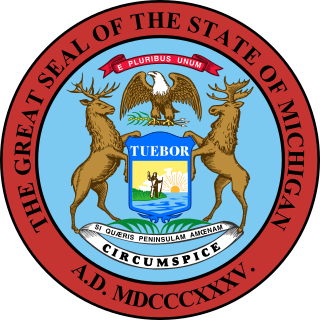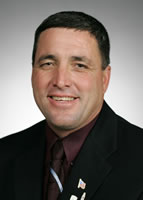Related Research Articles

The California State Senate is the upper house of the California State Legislature,the lower house being the California State Assembly. The state senate convenes,along with the state assembly,at the California State Capitol in Sacramento.

The Michigan Senate is the upper house of the Michigan Legislature. Along with the Michigan House of Representatives,it composes the state legislature,which has powers,roles and duties defined by Article IV of the Michigan Constitution,adopted in 1963. The primary purpose of the Legislature is to enact new laws and amend or repeal existing laws.

The Michigan House of Representatives is the lower house of the Michigan Legislature. There are 110 members,each of whom is elected from constituencies having approximately 77,000 to 91,000 residents,based on population figures from the 2020 U.S. census. Its composition,powers and duties are established in Article IV of the Michigan Constitution.

The New York State Senate is the upper house of the New York State Legislature,while the New York State Assembly is its lower house. Established in 1777 by the Constitution of New York,its members are elected to two-year terms with no term limits. There are 63 seats in the Senate. The Democratic Party has held control of the New York State Senate since 2019. The Senate Majority Leader is Andrea Stewart-Cousins.

The Senate of Virginia is the upper house of the Virginia General Assembly. The Senate is composed of 40 senators representing an equal number of single-member constituent districts. The Senate is presided over by the lieutenant governor of Virginia. Prior to the American War of Independence,the upper house of the General Assembly was represented by the Virginia Governor's Council,consisting of up to 12 executive counselors appointed by the colonial royal governor as advisers and jurists.

The Alabama State Senate is the upper house of the Alabama Legislature,the state legislature of the U.S. state of Alabama. The body is composed of 35 members representing an equal number of districts across the state,with each district containing at least 127,140 citizens. Similar to the lower house,the Alabama House of Representatives,the senate serves both without term limits and with a four-year term.

The Legislature of the State of Oklahoma is the state legislative branch of the U.S. state of Oklahoma. The Oklahoma House of Representatives and Oklahoma Senate are the two houses that make up the bicameral state legislature. There are 101 state representatives,each serving a two-year term,and 48 state senators,who serve four-year terms that are staggered so only half of the Oklahoma Senate districts are eligible in each election cycle. Legislators are elected directly by the people from single member districts of equal population. The Oklahoma Legislature meets annually in the Oklahoma State Capitol in Oklahoma City.

The Indiana Senate is the upper house of the Indiana General Assembly,the state legislature of the U.S. state of Indiana. The Senate is composed of 50 members representing an equal number of constituent districts. Senators serve four-year terms without term limits. According to the 2010 U.S. census,the average state senator represents 129,676 people.

The Oklahoma House of Representatives is the lower house of the legislature of the U.S. state of Oklahoma. Its members introduce and vote on bills and resolutions,provide legislative oversight for state agencies,and help to craft the state's budget. The upper house of the Oklahoma Legislature is the Oklahoma Senate.

The Oklahoma Senate is the upper house of the two houses of the Legislature of Oklahoma,the other being the Oklahoma House of Representatives. The total number of senators is set at 48 by the Oklahoma Constitution.

The president pro tempore of the Oklahoma Senate is the second-highest-ranking official of the Oklahoma Senate and the highest-ranking state senator. The Oklahoma Constitution designates the Lieutenant Governor of Oklahoma as the highest-ranking official,serving ex officio as President of the Senate,even though the lieutenant governor only votes in the case of a tie. During the lieutenant governor's absence,the president pro tempore presides over sessions. By longstanding custom,the lieutenant governor presides over sessions devoted to ceremonial purposes,while the bulk of the legislative management and political power is reserved for the president pro tempore,who is elected directly by the Oklahoma Senate.

The Democratic Party of Oregon is the Oregon affiliate of the Democratic Party. The State Central Committee,made up of two delegates elected from each of Oregon's 36 counties and one additional delegate for every 15,000 registered Democrats,is the main authoritative body of the party. The party has 17 special group caucuses which also each have representation on the State Central Committee.

The Fifty-first Oklahoma Legislature was a meeting of the legislative branch of the government of Oklahoma,composed of the Senate and the House of Representatives. State legislators met at the Oklahoma State Capitol in Oklahoma City from January 2,2007 to January 3,2009,during the first two years of the second term of Governor Brad Henry. A tie in the number of seats held by Republicans and Democrats in the Oklahoma Senate resulted in bipartisan leadership. Republicans held the majority of seats in the Oklahoma House of Representatives.

Charles A. Wyrick is an American politician from the U.S. state of Oklahoma. He served in the Oklahoma Senate,representing District 1,which includes Craig,Delaware and Ottawa counties. He served as Democratic whip. He was re-elected in 2008 and 2012. He was forced to retire in 2016 due to term limits set forth in the Oklahoma Constitution.

The Fifty-second Oklahoma Legislature was the meeting of the legislative branch of the government of Oklahoma in Oklahoma City from January 3,2009,to January 4,2011,during the second two years of the second administration of Governor Brad Henry. It was the first session in state history where the Republican Party has controlled both houses of the legislature.

The Fifty-fourth Oklahoma Legislature was the meeting of the legislative branch of the government of Oklahoma from January 8,2013 to January 5,2015. The first session met from February 4,2013,to May 24,2013,in the Oklahoma State Capitol in Oklahoma City,during the third year of the first administration of Governor Mary Fallin. After the 2012 elections,the Republican Party held more than two-thirds of the seats in the Oklahoma Senate and the Oklahoma House of Representatives.

The Fiftieth Oklahoma Legislature was a meeting of the legislative branch of the government of Oklahoma,composed of the Senate and the House of Representatives. It met in Oklahoma City from January 4,2005 to January 2,2007,during the second two years of the first term of Governor Brad Henry. The Democratic Party held the majority of the state senate seats and the Republican Party held the majority of seats in the Oklahoma House of Representatives. The 2005 session was marked by the enactment of the Tax Relief Act of 2005. The 2006 session was marked by the enactment of the Kelsey Smith-Briggs Child Protection Reform Act.

The Forty-ninth Oklahoma Legislature was a meeting of the legislative branch of the government of Oklahoma,composed of the Senate and the House of Representatives. It met in Oklahoma City from January 7,2003 to January 4,2005,during the first two years of the first term of Governor Brad Henry. It was marked by the passage of a ballot proposal,the Oklahoma Education Lottery Act.

The Forty-seventh Oklahoma Legislature was a meeting of the legislative branch of the government of Oklahoma,composed of the Senate and the House of Representatives. It met in Oklahoma City from January 5,1999,to January 2,2001,during the first two years of the second term of Governor Frank Keating.
References
- 1 2 3 4 Results of 2003 Special Election,Oklahoma State Election Board (accessed April 29,2013)
- ↑ 2008 Election Results [ permanent dead link ],Oklahoma State Election Board (accessed April 29,2013)
- ↑ 2004 Primary Results [ permanent dead link ],Oklahoma State Election Board (accessed April 29,2013)